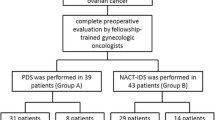Abstract
Human epididymis protein 4 (HE4) has recently been described as a new marker for the early diagnosis of ovarian cancer (OC). The objective of this study was to evaluate (a) the expression of HE4 vs. OC mucin CA125 in 32 patients with OC compared to 163 patients with other malignant or benign pathologies (b) HE4 as indicator of the recurrence of the disease in eight patients followed-up for 20 months after OC diagnosis. Serum HE4 and CA 125 levels were determined by ELISA and IRMA, respectively. At diagnosis, the patients with OC demonstrated high levels of both biomarkers with 96.9% sensitivity for HE4 and 85.7% for CA125. In the other pathologies there was 3.7% positivity for HE4 and 21.0% for CA125. The follow-up study showed an increase of HE4 5–8 months before CA125 increment in five of the eight patients, this early expression being strictly associated to a relapse of the disease. In conclusion, this study showed that HE4, compared to CA125, potentially is a better marker for the diagnosis of OC and could be an important early indicator of the recurrence of the disease.



Similar content being viewed by others
References
Ozols RF. Recurrent ovarian cancer: evidence-based treatment. J Clin Oncol. 2002;20:1161–3.
Parkin DM, Pisani P, Ferlay J. Estimates of the worldwide incidence of 25 major cancers in 1990. Int J Cancer. 1999;80:827–41.
Jemal A, Siegel R, Ward E, Hao Y, Xu J, Murray T, et al. Cancer statistics, 2008. CA Cancer J Clin. 2008;58:71–6.
Haries M, Gore M. Part I: chemotherapy for epithelial ovarian cancer-treatment at first diagnosis. Lancet Oncol. 2002;3:529–36.
Pecorelli S, Creasman WT, Petterson F, Benedet JL, Shepard JH. FIGO annual report on the results of treatment in gynaecological cancer. J Epidemiol Biostat. 1988;3:75–102.
Rosen DG, Wang L, Atkinson JN, Yu Y, Lu KH, Diamandis EP, et al. Potential markers that complement expression of CA125 in epithelial ovarian cancer. Gynecol Oncol. 2005;99:267–77.
Bast Jr RC, Badgwell D, Marquez LR, Rosen D, Liu J, Baggerly KA, et al. New tumor markers: CA125 and beyond. Int J Gynecol Cancer. 2005;15:274–81.
Chen DX, Schwartz PE, Li XG, Yang Z. Evaluation of CA 125 levels in differentiating malignant from benign tumors in patients with pelvic mass. Obstet Gynecol. 1988;72:23–7.
Medeiros LR, Rosa DD, da Rosa MI, Bozzetti MC. Accuracy of CA 125 in the diagnosis of ovarian tumors: a quantitative systematic review. Eur J Obstet Gynecol Reprod Biol. 2009;142:99–05.
Tian C, Markman M, Zaino R, Ozols RF, McGuire WP, Muggia FM, et al. CA-125 change after chemotherapy in prediction of treatment outcome among advanced mucinous and clear cell epithelial ovarian cancers: a Gynecologic Oncology Group study. Cancer. 2009;115:1395–403.
Urban N, McIntosh M, Andersen M, Karlan B. Ovarian cancer screening. Hematol Oncol Clin North Am. 2003;17:989–05.
Kirchhoff C. Molecular characterization of epididymal proteins. Rev Reprod. 1998;3:86–5.
Bingle L, Singleton V, Bingle CD. The putative ovarian tumor marker gene HE4 (WFDC2), is expressed in normal tissues and undergoes complex alternative splicing to yield multiple protein isoforms. Oncogene. 2002;21:2768–73.
Clauss A, Lilja H, Lundwall A. The evolution of a genetic locus encoding small serine proteinase inhibitors. Biochem Biophys Res Commun. 2005;333:383–9.
Clauss A, Lilja H, Lundwall A. A locus on human chromosome 20 contains several genes expressing protease inhibitor domains with homology to whey acid protein. Biochem J. 2002;368:233–42.
Drapkin R, von Horsten HH, Lin Y, Mok SC, Crum CP, Welch WR, et al. Human epididymis protein 4 (HE4) is a secreted glycoprotein that is overexpressed by serous and endometrioid ovarian carcinomas. Cancer Res. 2005;65:2162–9.
McIntosh MW, Drescher C, Karlan B, Scholler N, Urban N, Hellstrom KE, et al. Combining CA 125 and SMR serum markers for diagnosis and early detection of ovarian carcinoma. Gynecol Oncol. 2004;95:9–15.
Galgano MT, Hampton GM, Frierson Jr HF. Comprehensive analysis of HE4 expression in normal and malignant human tissues. Mod Pathol. 2006;19:847–53.
Moore RG, Brown AK, Miller MC, Kates S, Allard WJ, Verch MS, et al. The use of multiple novel tumor biomarkers for the detection of ovarian carcinoma in patients with a pelvic mass. Gynecol Oncol. 2008;108:402–8.
Moore RG, Brown AK, Miller CM, Badgwell D, Lu Z, Allard J, et al. Utility of a novel serum tumor biomarker HE4 in patients with endometrial adenocarcinoma of the uterus. Gynecol Oncol. 2008;108:196–201.
Schink JC. Current initial therapy of stage II and IV ovarian cancer: challenges for managed care. Sem Oncol. 1999;26:2–7.
Moorman PG, Calingaert B, Palmieri RT, Iversen ES, Bentley RC, Halabi S, et al. Hormonal risk factors for ovarian. Am J Epidemiol. 2008;167:1059–69.
Duffy MJ, Bonfrer JM, Kulpa J, Rustin GJ, Soletormos G, Tuxen TGC, et al. CA125 in ovarian cancer: European Group on Tumor Markers guidelines for clinical use. Int J Gynecol Cancer. 2005;15:679–91.
Hellerstrom I, Hellerstron KE. SMRP and HE4 as biomarkers for ovarian carcinoma when used alone and in combination with CA125 and/or each other. Adv Exp Med Biol. 2008;622:15–21.
Allard J, Somers E, Theil R, Moore RG. Use of a novel biomarker HE4 for monitoring patients with epithelial ovarian cancer. Annual meeting of the ASCO 2008 Abstract.
Carroll JC, Cremin C, Allanson J, Blaine SM, Dorman H, Gibbons CA, et al. Hereditary breast and ovarian cancers. Can Fam Physician. 2008;54:1691–2. Review.
Fasching PA, Gayther S, Pearce L, Schildkraut JM, Goode E, Thiel F, et al. Role of genetic polymorphisms and ovarian cancer susceptibility. Mol Oncol. 2009;3:171–81.
Acknowledgments
This study is founded by The University of Rome “Sapienza”. We are thankful to Barbara Colaprisca and Silvestra Tudini for their technical assistance, to Prof. Mauizio Sensi, Prof. Susanna Morano and Claudio Tiberti for helpful comments and discussion, and Prof. Bruno Annibale for his contribution to the statistical work.
Conflict of interest statement
None.
Author information
Authors and Affiliations
Corresponding author
Rights and permissions
About this article
Cite this article
Anastasi, E., Giovanna Marchei, G., Viggiani, V. et al. HE4: a new potential early biomarker for the recurrence of ovarian cancer. Tumor Biol. 31, 113–119 (2010). https://doi.org/10.1007/s13277-009-0015-y
Received:
Accepted:
Published:
Issue Date:
DOI: https://doi.org/10.1007/s13277-009-0015-y




